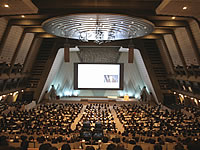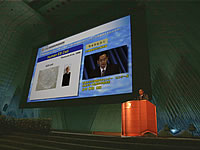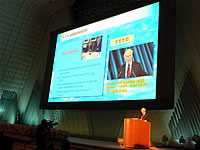
Japan Science and Technology Agency (JST) hold International Symposium on "Induced Pluripotent Stem (iPS) Cell Research - Frontier and Future -" at Kyoto International Conference Center over two days from May 11 to 12, 2008 (In association with the Cabinet Office, the Ministry of Foreign Affairs (MOFA), the Ministry of Education, Culture, Sports, Science and Technology (MEXT), the Ministry of Health, Labor and Welfare (MHLW), the Ministry of Economy, Trade and Industry (METI), Kyoto University, Cell Press).
The purpose of the symposium was to further advance the research into iPS (induced pluripotent stem) cells, the epoch-making research finding of Prof. Shinya Yamanaka and his colleagues at Kyoto University. Before an audience of about 1,200, 16 leading Japanese and overseas stem cell researchers gave presentations on the latest research, and discussed the future direction of research and approaches to international cooperation.
The first day of the symposium started with an opening address by Hiroo Imura, Principal Fellow of the Center for Research and Development Strategies, JST. Next, guest Kisaburo Tokai, Minister of MEXT spoke, saying, "The establishment of iPS cells is a great achievement in the history of life sciences. I hope that government and industry will offer whatever cooperation they can".
This was followed by three sessions under the agenda of "Latest Findings in iPS Cell-Related Research and Future Perspectives in Science and Technology". In Session 1 "Frontier Research on iPS Cell", there were lectures from Prof. Yamanaka and Prof. Rudolf Jaenisch of the Massachusetts Institute of Technology (USA).

Prof. Yamanaka said, "We succeeded in establishing human iPS cells only one year after establishing mouse iPS cells. What allowed us to go from mice to humans in such a short time were the findings in the basic area of ES (embryonic stem) cell research, accumulated over a long period. iPS cells are forcibly-made artificial material, and they're different from naturally occurring ES cells. In future, to promote the development of stem cell research with a view to realizing regenerative medicine, we must continue research using a variety of means, and not only iPS cells". Since similar thoughts were expressed repeatedly by subsequent speakers, it is evident that this is a common view among researchers involved with iPS and ES cells.
Prof. Jaenisch is pursuing research aiming to clarify the reprogramming mechanism of cell differentiation displayed by iPS cells, and he noted that it is important to be familiar with ES cells. He spoke specifically of the differences between ES cells and iPS cells in the development of regenerative medicine, and he also talked about the state of progress in the latest research into treatment of sickle cell anemia and Parkinson's disease.
In Session 2 "Identification and Induction of Pluripotency", there were lectures from three researchers on the basic properties of stem cells. Prof. Peter W. Andrews of the University of Sheffield (UK) spoke about the factors that determine maintenance of pluripotency and induction of differentiation. Sheng Ding, Associate Professor of the Scripps Research Institute (USA) talked about induction of pluripotency using chemicals. Ying Jin, Professor of Shanghai Institutes for Biological Sciences, Chinese Academy of Sciences / Shanghai JiaoTong University of Medicine (China) spoke about the function of Oct4, one of the pluripotency-inducing factors.
In Session 3 titled "Tissue Commitments of Pluripotent Stem Cells", there were four lectures centered on advances in stem cell research with a view to achieving regenerative medicine. Prof. Joseph Itskovitz-Eldor of Israel Institute of Technology talked about the current situation at the Stem Cell Research Center in Israel and differentiation into heart and bone cells. Prof. Hideyuki Okano of Keio University (Japan) spoke about regeneration of the central nervous system in primates. Masayo Takahashi, Team-leader of the Center for Developmental Biology (CDB), RIKEN (Japan) spoke about retinal regeneration research and expressed an opinion as a clinician. Prof. Henrik Semb, Lund University (Sweden) talked about fundamental cures for Type 1 diabetes using regeneration of the tissues that produce insulin.

At the start of the second day, Sir Martin Evans of Cardiff University (UK), Nobel Prize Laureate in Medicine 2007, gave the keynote speech.
While Sir Martin spoke figuratively of Prof. Yamanaka's achievement as "magic", he suggested that it was not a matter for undue elation, and he emphasized, "Now, more than ever, we need to know and understand the basics of cellular biology". Although there are still technical and cost issues with specific treatments using iPS cells for tailor-made medicine, he spoke of his hope; "The future is bright".
There were as many questions from the audience for Sir Martin as for Prof. Yamanaka. He responded graciously to each question about the difficulties he encountered and with words of encouragement for young researchers. His sincerity as a researcher was evident from his statement that "There must be scientific evidence behind all medicine"
Next, under the agenda of "Strategies for the Acceleration of Pluripotent Stem Cell-Related Research", Tasuku Honjo, Executive Member of Council of Science and Technology Policy of Japan opened the proceedings with an introductory talk explaining the government's policy in support of iPS cells. This was followed by two sessions.
In Session 4 "Pluripotent Stem Cell-Related Research Activities", there were six lectures reporting on the latest trends in stem cell research around the world. Prof. Irving L. Weissman of Stanford University (USA) spoke about hematopoietic stem cells. Hans R. Schöler, Director of the Max Planck Institute for Molecular Biomedicine (Germany) spoke about germline stem cells and gPS (induced pluripotent germline stem) cells. Alan Colman, Executive Director of the Singapore Stem Cell Consortium spoke about the state of stem cell research in Singapore.
Next Prof. Kwang-Soo Kim of Pochon CHA University (Korea) spoke of establishing iPS cells from rat neural precursor cells for pharmaceutical research. Prof. Norio Nakatsuji of Kyoto University (Japan) who is leading Japan's ES cell research spoke about the system and strategy for ES/iPS cell research at Kyoto University. Stephen Livesey, CEO of the Australian Stem Cell Centre gave a presentation on research in Australia and the stem cell research network in the Asia Pacific region.
Session 5, the last, was "Panel Discussion on International Cooperation in Pluripotent Stem Cell-Related Research". Shin-ichi Nishikawa, Deputy Director of CDB, RIKEN was the coordinator while Prof. Jaenisch, Prof. Weissman, Prof. Itskovitz-Eldor, Director Scholer, Prof. Andrews, Dr. Robert A. Goldstein, Chief Scientific Officer of the Juvenile Diabetes Research Foundation International (USA), and Dr. Jyotsna Dhawan, Group Leader at the Centre for Cellular and Molecular Biology (India) took part as panelists. The panelists discussed specific approaches to international cooperation.
Prof. Weissman noted that "The approach of different peoples to stem cell research in each country differs according to their religion, politics, and ideologies. In creating international standards, we won't achieve anything if we try to make allowance for the regulations of each country to eliminate risk". In response, Group Leader Dhawan concluded the discussion with the statement, "For international cooperation, rather than regulations, exchange is important".
Most of the talks were presented in English with simultaneous translation. Since it was focused on leading edge research findings, the content was quite specialized, but the large audience listened closely until the end of the second day. In closing, President Koichi Kitazawa of JST noted on behalf of the organizers, "I understand that stem cell research is spreading far and wide. I was very impressed by the sincerity with which all the clinical researchers are working intently to understand how best to help their patients, and the conscientiousness of everybody involved in this research." With these words of encouragement to the people involved in iPS/ES cell research, the symposium concluded successfully.